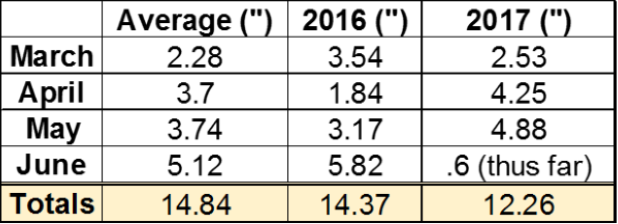
In recent years, Nitrogen Management has become one of the biggest focus areas in manufacturing, retail, and to growers. Once was a time when we had little control over how and when nitrogen was managed for the corn plant when often, it is the plant’s most limited resource. As farming becomes smarter and the markets tighten, we become more cautious of how we are allocating our resources, specifically the timing in which we apply nitrogen and the tools we use to protect that investment.
Spreading out nitrogen applications has allowed corn plants to utilize their nitrogen when needed. We can decipher when the corn plant needs its nitrogen most by tissue and soil sampling throughout the growing season, but what we can’t control is the weather and when we can get in the field to spoon-feed the corn. In the last few months, we’ve seen above-average rainfall from both the average and 2016. The major difference in this year’s pattern is when the rainfall occurred. In the midst of planting, the Darlington area saw large amounts and time periods of rain throughout April and May, causing delayed planting in many surrounding areas and the application of nitrogen deferred.
With the spring we’ve had, there will be many acres that receive the majority of their nitrogen in a topdress or sidedress application. These applications can begin as early as V2 and into VT corn, but the largest portion of nitrogen is taken up by the plant from the V8 to VT time period. Furthermore, it is recommended that if there is no prior nitrogen applied, a V6 or earlier application timing is optimal.
In addition to application timing, another way to protect your spring-applied nitrogen is to use a Nitrogen Stabilizer. Last issue, Mark Kendall wrote an article describing the different types of Nitrogen Stabilizers and different ways to use them. Using products like N-Serve, Instinct II, and AgroTain have been shown to bump yield, even in late-season applications. University research tell us that ammonium can convert to nitrate (a less stable form of nitrogen) in as little as two to four weeks in warm, wet growing conditions. If we think about when the corn plant needs its nitrogen most, we could have a one to four week gap between our nitrogen application and when the plant begins rapid uptake of applied nitrogen. A Nitrogen Stabilizer will extend nitrogen’s residual in the soil so it’s still there when the corn plant is ready.
Looking back, this spring has been a struggle across the state of Wisconsin. Rain events have delayed field work, planting, and nitrogen applications but looking forward, the best thing we can do is optimize our applications of nitrogen with proper timing and utilizing tools like Nitrogen Stabilizers to get corn into pollination. Contact your WS Ag Agronomist to see how you can optimize your yield potential this spring.
Abbey Edel, Dow AgroSciences